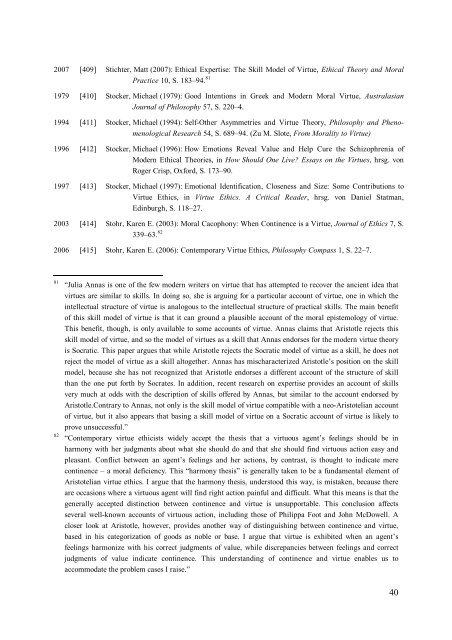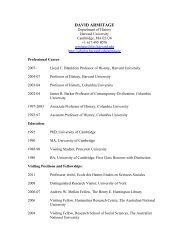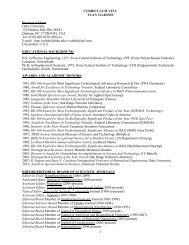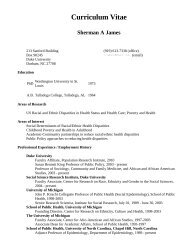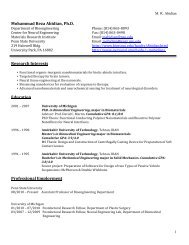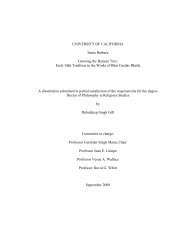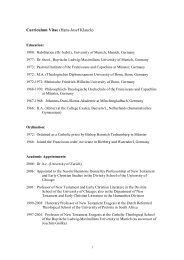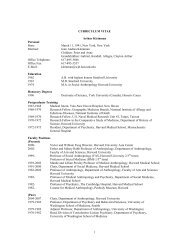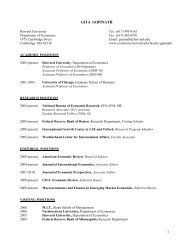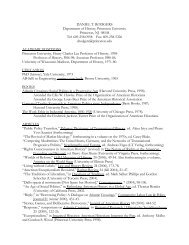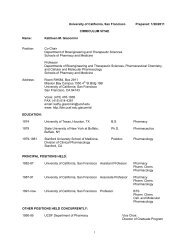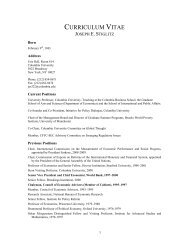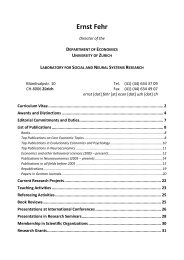2007 [409] Stichter, Matt (2007): Ethical Expertise: The Skill Model of <strong>Virtue</strong>, Ethical Theory and MoralPractice 10, S. 183–94. 811979 [410] Stocker, Michael (1979): Good Intenti<strong>on</strong>s in Greek and Modern Moral <strong>Virtue</strong>, AustralasianJournal of Philosophy 57, S. 220–4.1994 [411] Stocker, Michael (1994): Self-Other Asymmetries and <strong>Virtue</strong> Theory, Philosophy and PhenomenologicalResearch 54, S. 689–94. (Zu M. Slote, From Morality to <strong>Virtue</strong>)1996 [412] Stocker, Michael (1996): How Emoti<strong>on</strong>s Reveal Value and Help Cure the Schizophrenia ofModern Ethical Theories, in How Should One Live? Essays <strong>on</strong> the <strong>Virtue</strong>s, hrsg. v<strong>on</strong>Roger Crisp, Oxford, S. 173–90.1997 [413] Stocker, Michael (1997): Emoti<strong>on</strong>al Identificati<strong>on</strong>, Closeness and Size: Some C<strong>on</strong>tributi<strong>on</strong>s to<strong>Virtue</strong> Ethics, in <strong>Virtue</strong> Ethics. A Critical Reader, hrsg. v<strong>on</strong> Daniel Statman,Edinburgh, S. 118–27.2003 [414] Stohr, Karen E. (2003): Moral Cacoph<strong>on</strong>y: When C<strong>on</strong>tinence is a <strong>Virtue</strong>, Journal of Ethics 7, S.339–63. 822006 [415] Stohr, Karen E. (2006): C<strong>on</strong>temporary <strong>Virtue</strong> Ethics, Philosophy Compass 1, S. 22–7.8182“Julia Annas is <strong>on</strong>e of the few modern writers <strong>on</strong> virtue that has attempted to recover the ancient idea thatvirtues are similar to skills. In doing so, she is arguing for a particular account of virtue, <strong>on</strong>e in which theintellectual structure of virtue is analogous to the intellectual structure of practical skills. The main benefitof this skill model of virtue is that it can ground a plausible account of the moral epistemology of virtue.This benefit, though, is <strong>on</strong>ly available to some accounts of virtue. Annas claims that Aristotle rejects thisskill model of virtue, and so the model of virtues as a skill that Annas endorses for the modern virtue theoryis Socratic. This paper argues that while Aristotle rejects the Socratic model of virtue as a skill, he does notreject the model of virtue as a skill altogether. Annas has mischaracterized Aristotle’s positi<strong>on</strong> <strong>on</strong> the skillmodel, because she has not recognized that Aristotle endorses a different account of the structure of skillthan the <strong>on</strong>e put forth by Socrates. In additi<strong>on</strong>, recent research <strong>on</strong> expertise provides an account of skillsvery much at odds with the descripti<strong>on</strong> of skills offered by Annas, but similar to the account endorsed byAristotle.C<strong>on</strong>trary to Annas, not <strong>on</strong>ly is the skill model of virtue compatible with a neo-Aristotelian accountof virtue, but it also appears that basing a skill model of virtue <strong>on</strong> a Socratic account of virtue is likely toprove unsuccessful.”“C<strong>on</strong>temporary virtue ethicists widely accept the thesis that a virtuous agent’s feelings should be inharm<strong>on</strong>y with her judgments about what she should do and that she should find virtuous acti<strong>on</strong> easy andpleasant. C<strong>on</strong>flict between an agent’s feelings and her acti<strong>on</strong>s, by c<strong>on</strong>trast, is thought to indicate merec<strong>on</strong>tinence – a moral deficiency. This “harm<strong>on</strong>y thesis” is generally taken to be a fundamental element ofAristotelian virtue ethics. I argue that the harm<strong>on</strong>y thesis, understood this way, is mistaken, because thereare occasi<strong>on</strong>s where a virtuous agent will find right acti<strong>on</strong> painful and difficult. What this means is that thegenerally accepted distincti<strong>on</strong> between c<strong>on</strong>tinence and virtue is unsupportable. This c<strong>on</strong>clusi<strong>on</strong> affectsseveral well-known accounts of virtuous acti<strong>on</strong>, including those of Philippa Foot and John McDowell. Acloser look at Aristotle, however, provides another way of distinguishing between c<strong>on</strong>tinence and virtue,based in his categorizati<strong>on</strong> of goods as noble or base. I argue that virtue is exhibited when an agent’sfeelings harm<strong>on</strong>ize with his correct judgments of value, while discrepancies between feelings and correctjudgments of value indicate c<strong>on</strong>tinence. This understanding of c<strong>on</strong>tinence and virtue enables us toaccommodate the problem cases I raise.”40
2010 [416] Stohr, Karen E. (2010): Teaching & Learning Guide for: C<strong>on</strong>temporary <strong>Virtue</strong> Ethics,Philosophy Compass 5, S. 102–7.1992 [417] Strauss, David A. (1992): The Liberal <strong>Virtue</strong>s, in <strong>Virtue</strong> (Nomos 34), hrsg. v<strong>on</strong> John W.Chapman und William A. Galst<strong>on</strong>, New York, S. 197–203.1998 [418] Sumner, L. W. (1998): Is <strong>Virtue</strong> Its Own Reward?, in <strong>Virtue</strong> and Vice, hrsg. v<strong>on</strong> Ellen FrankelPaul, Fred D. Miller, Jr. und Jeffrey Paul, Cambridge, S. 18–36.2010 [419] Svenss<strong>on</strong>, Frans (2010): <strong>Virtue</strong> Ethics and the Search for an Account of Right Acti<strong>on</strong>, EthicalTheory and Moral Practice 13, S. 255–71. 831993 [420] Swant<strong>on</strong>, Christine (1993): Commentary <strong>on</strong> Michael Slote’s “<strong>Virtue</strong> Ethics and DemocraticValue”, Journal of Social Philosophy 24, S. 38–49.1993 [421] Swant<strong>on</strong>, Christine (1993): Satisficing and <strong>Virtue</strong>, Journal of Philosophy 90, S. 33–48.1995 [422] Swant<strong>on</strong>, Christine (1995): Profiles of the <strong>Virtue</strong>s, Pacific Philosophical Quarterly 76, S. 47–72.1997 [423] Swant<strong>on</strong>, Christine (1997): <strong>Virtue</strong> Ethics and Satisficing Rati<strong>on</strong>ality, <strong>Virtue</strong> Ethics. A CriticalReader, hrsg. v<strong>on</strong> Daniel Statman, Edinburgh 1997, S. 82–98. (Revidierte Versi<strong>on</strong> v<strong>on</strong>“Satisficing and <strong>Virtue</strong>” (1993))1997 [424] Swant<strong>on</strong>, Christine (1997): The Supposed Tensi<strong>on</strong> Between ‘Strength’ and ‘Gentleness’ C<strong>on</strong>cepti<strong>on</strong>sof the <strong>Virtue</strong>s, Australasian Journal of Philosophy 75, S. 497–510.1997 [425] Swant<strong>on</strong>, Christine (1997): <strong>Virtue</strong> Ethics and the Problem of Indirecti<strong>on</strong>: A Pluralistic Value-Centered Approach, Utilitas 9, S. 167–81.2001 [426] Swant<strong>on</strong>, Christine (2001): A <strong>Virtue</strong> Ethical Account of Right Acti<strong>on</strong>, Ethics 112, S. 32–52.2001 [427] Swant<strong>on</strong>, Christine (2001): <strong>Virtue</strong> Ethics, Value-centredness, and C<strong>on</strong>sequentialism, Utilitas13, S. 213–35.2003 [428] Swant<strong>on</strong>, Christine (2003): <strong>Virtue</strong> Ethics. A Pluralistic View, Oxford.2004 [429] Swant<strong>on</strong>, Christine (2004): Satisficing and Perfecti<strong>on</strong>ism in <strong>Virtue</strong> Ethics, in Satisficing andMaximizing: Moral Theorists <strong>on</strong> Practical Reas<strong>on</strong>, hrsg. v<strong>on</strong> Michael Byr<strong>on</strong>, Cambridge,S. 176–89.83“C<strong>on</strong>ceived of as a c<strong>on</strong>tender to other theories in substantive ethics, virtue ethics is often associated with, inessence, the following account or criteri<strong>on</strong> of right acti<strong>on</strong>: VR: An acti<strong>on</strong> A is right for S in circumstancesC if and <strong>on</strong>ly if a fully virtuous agent would characteristically do A in C. There are serious objecti<strong>on</strong>s to VR,which take the form of counter-examples. They present us with different scenarios in which less than fullyvirtuous pers<strong>on</strong>s would be acting rightly in doing what no fully virtuous agent would characteristically do inthe circumstances. In this paper, various proposals for how to revise VR in order to avoid these counterexamplesare c<strong>on</strong>sidered. I will argue that in so far as the revised accounts really do manage to steer clear ofthe counter-examples to VR, something which it turns out is not quite true for all of them, they instead fallprey to other damaging objecti<strong>on</strong>s. I end by discussing the future of virtue ethics, given what has come tolight in the previous secti<strong>on</strong>s of the paper. In particular, I sketch the outlines of a virtue ethical account ofrightness that is structurally different from VR. This account also faces important problems. Still, I suggestthat further scrutiny is required before we are in a positi<strong>on</strong> to make a definitive decisi<strong>on</strong> about its fate.”41
- Page 1: Literatur
- Page 4 and 5: national Journal of Management Revi
- Page 6: 53.2010 [39] Battaly, Heather (2010
- Page 9 and 10: 2005 [60] Brady, Michael S. (2005):
- Page 11 and 12: 2008 [72] Calhoun, Cheshire (2008):
- Page 13 and 14: 1998 [93] Cooper, John M. (1998): T
- Page 15 and 16: 2005 [120] Doris, John M. (2005): R
- Page 17 and 18: 1978 [138] Foot, Philippa (1978): V
- Page 19 and 20: 1996 [166] Griffin, James (1996): V
- Page 21 and 22: 166-84.1996 [188] Hooker, Brad (199
- Page 23 and 24: Theory and Moral Practice 8, S. 387
- Page 25 and 26: Ethics, hrsg. von Patricia H. Werha
- Page 27 and 28: Deutsche Zeitschrift für Philosoph
- Page 29 and 30: 2009 [280] Miller, Christian (2009)
- Page 31 and 32: 2000 [299] Oderberg, David S. (2000
- Page 33 and 34: Moral Education 24, S. 175-184.1997
- Page 35 and 36: Southern Journal of Philosophy 14,
- Page 37 and 38: 1997 [379] Slote, Michael (1997): V
- Page 39: 2009 [401] Sreenivasan, Gopal (2009
- Page 43 and 44: 2008 [441] Tessman, Lisa (2008): Re
- Page 45 and 46: 2009 [457] van Zyl, Liezl (2009): A
- Page 47 and 48: 2006 [475] Webber, Jonathan (2006):
- Page 49 and 50: 2008 [484] White, Richard (2008): R


